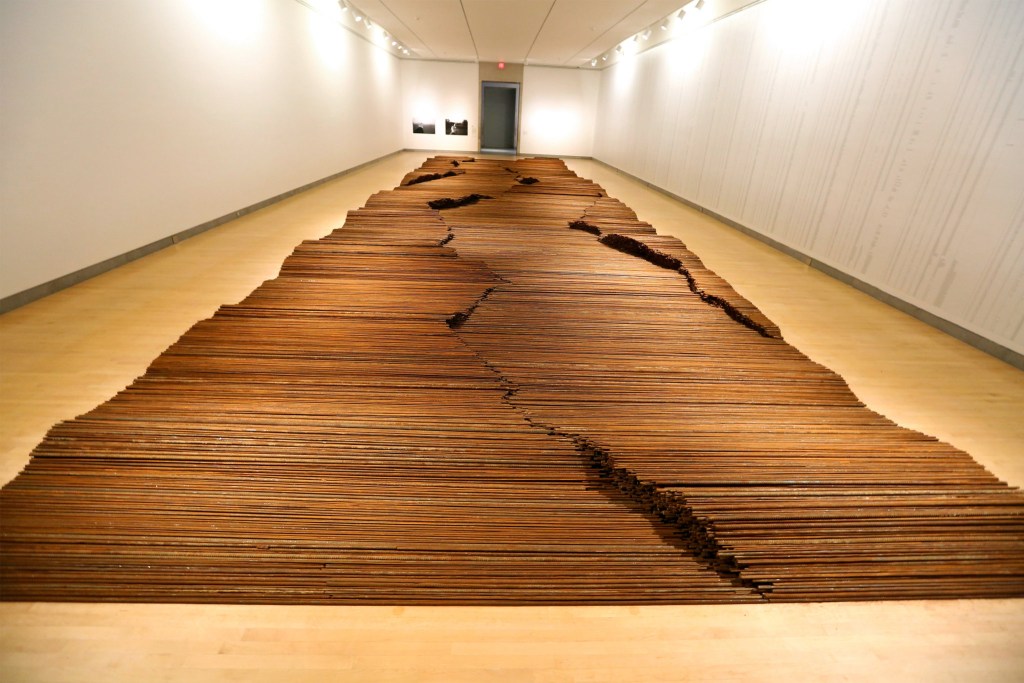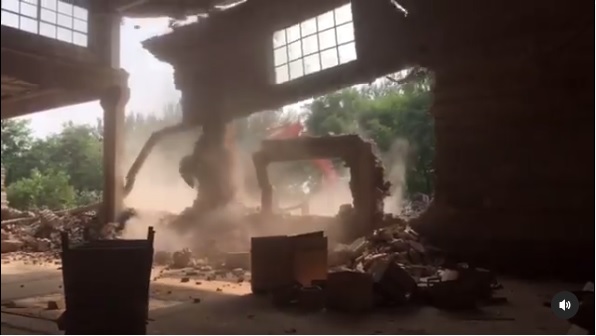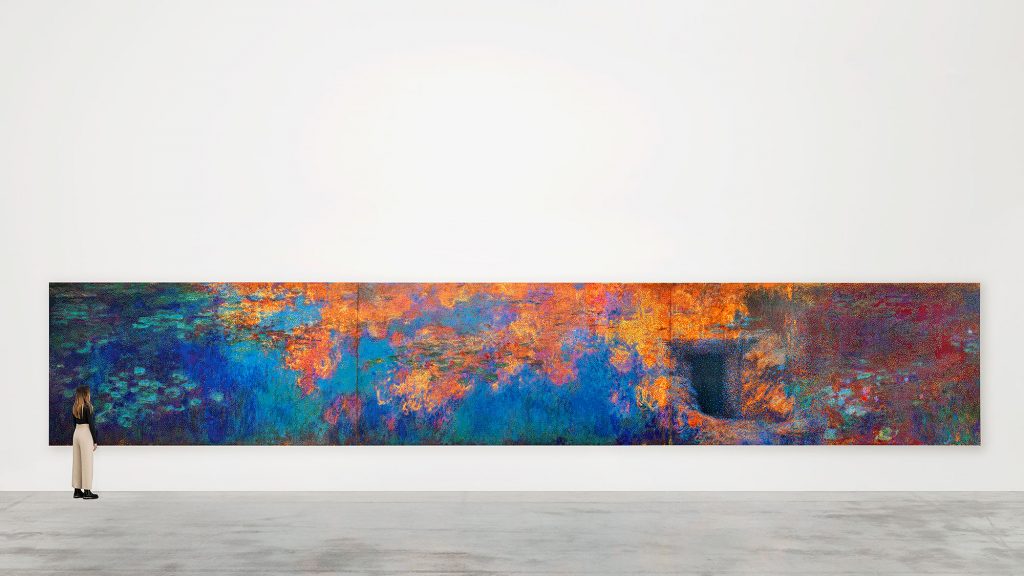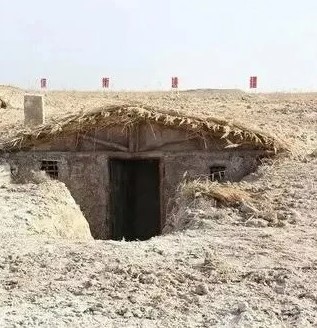An Interview With Ai Weiwei, Part Two: Ruins. Rebars. Water Lilies.
An Interview With Ai Weiwei, Part Two: Ruins. Rebars. Water Lilies.

(Continued from Part One: The Year 2008)
Ruins. Rebars. Water Lilies.
YC: Many details have left a deep impression on me from reading your autobiography. I want to bring up two ruins in front of which you stood. One is the ruins of schools that collapsed in the Wenchuan earthquake in May 2008, where you and your assistant arrived for a first-hand experience. You described the twisted steel bars exposed in the ruins, and you talked about a couple you met, whose child was one of the students who was crushed to death in the ruins. The other scene is from a day in January 2011, when you arrived at Malu (马陆) outside Shanghai at sunset. That was where your newly completed Shanghai studio was being forcibly demolished. As I said, this book is exceptionally well-translated, it says: “Under the setting sun, four wrecking machines were still waving their huge arms, and all that was left of my studio was a section of wall in the northeast corner.” So here is Ai Weiwei, at different times, in different places, standing in front of ruins, each profoundly painful. I’d like to hear your thoughts.
AWW: Now you mention it, I recall that my father actually wrote two poems about ruins. One is about Jiaohe (referring to Ai Qing’s 1997 poem “The Ruins of the Ancient Jiaohe City”《交河古城遗址》). The title of my book, A Thousand Years of Joys and Sorrows, is a quote from this poem of his.
His idea was that the ancient city of Jiaohe, which is now almost completely submerged by the desert, was once a bustling place. Standing there now, who could have imagined this place was once, for a millennium, teeming with life, full of carriages and commerce, joys and sorrows. He says that the living should live the best they can and not expect the earth to retain their memory. That is the sentiment of the poem.
He also had a poem, a long one, about the Roman Colosseum, which is also a ruin now. Actually he mentioned the Colosseum several times. He wrote that when archaeologists found a bone, how could they know that this bone had been burned by the flames of the 20th century? So these are the ruins that my father encountered, and he felt deeply about these sort of scenes. As for me, I went to the Wenchuan earthquake site to gain personal clarity about this world, instead of merely joining a chorus of condemnations or lamentations with others.
I wanted to stand in that ruin, in the rubble, to learn what it was like when the wind and air engulfed you in a disaster. I did this, and it was a chance for self-improvement, self-understanding.


The second time was when I learned my studio, which the officials had said would not be demolished for the time being, was being attacked and destroyed by the government. I flew over and saw my studio, a beautiful structure that had just been built and the interior furnished and decorated recently. The government’s plan was to demolish it within a day, including removing the rubble and turning the lot back to farmland overnight. I think the Shanghai authorities are the most wicked and shameless of all — the management in Shanghai, including what their public security officers did to Yang Jia.
So I wanted to experience it first-hand, because without experiencing it, you can’t actually feel this sense of humiliation. Only when you stand in the midst of it, could you begin to think: Why? Why are they doing this? What’s sustaining this society? Who are those who operate this society? You would ask these questions; ordinary people — and I am also only an ordinary person — would ask such questions.
Indeed, I’ve seen other ruins as well. After I arrived in Germany in 2015, I visited the Greek island of Lesbos. I stood on the shore and saw with my own eyes how the refugees landed, how they trudged towards the shore from the sea, how they tossed their life jackets onto the shore and discarded their rubber boats. Many people died there. It was a crisis of human refugees, a ruin of humanity. Afterwards, I visited dozens of refugee camps and many, many unfortunate places. So, I’ve experienced at least three major ruins.
YC: The other day, as you were stir-frying dishes for lunch, you mentioned that the first 10 years of the lively internet expression in China was just a “crevice” when the censorship machinery of autocracy was still catching up. But wouldn’t you say that for a large group of people in China, those ten years were a period of an explosion in free speech?
AWW: Let’s not exaggerate. First of all, there’s no such thing as a ‘large group’ in China; China is just a field of weeds. When there’s no weed killer, it grows wildly for a while. It was a time of rampant weeds, not an explosion. It was also a strange phenomenon, a proliferation of weeds.
YC: Regardless,do those years of rampant weeds growing leave a legacy among the people?
AWW: Well, it did leave something… much like someone passing a very stinky fart, after a while, it disappears with a gust of wind. In the grand scheme of things, it doesn’t hold much significance. When we talk about significance, we mean, did it influence a generation? Did it give rise to a generation of so-called activists, elites? Just take a tally, for example, of 20 [influential] people from that time, what are they doing now? If there are still active people now, what are they doing? China is a society without structure, without ecology. It’s a society without religion. It’s a society without national or racial characteristics. It is a society of “no predecessors, no successors,” a society of loose sand. In Chinese society, the more systematically organized people are actually those who are not Chinese, like Tibetans or Uyghurs, because they have a religion, a nationality, a language, or customs. That will not change, no matter how hard the CCP tries to assimilate them or make them disappear. As for the Han people, the so-called Han people, there is no Han nationality. Mongolians have basically been assimilated. So have the Manchurians.
YC: Continue on the decade or so that you characterized as years of rampant growth of weeds… Would you consider yourself a product of that phenomenon?
AWW: I was a toxic weed, so to speak, but I was quickly eradicated. In as early as 2009, I was blocked from the internet, probably one of the first to be. Think about it, it was just after 2008. Then by 2011, I was arrested, and by 2015, I left China. What more is there to say? In Chinese society, you are insignificant, as simple as that: first, they silence you, then they smear you, or lock you up. With me, they were rather merciful, simply allowing me to leave.
YC: Many people saw your exhibition of 100 million sunflower seeds. I don’t know if you yourself ever wrote it this way, but in your autobiography, you wrote that some viewers think the sunflower seeds symbolize the seeds of freedom. Do you think there are seeds of freedom in China? Or is this what your sunflower seeds are meant to express?
AWW: No, I feel that discussing works of art in such simplistic terms is generally superficial. But nonetheless it’s also a way of expression, because people can’t find, and don’t have, the correct vocabulary to describe something new. This is also why I am reluctant to explain my works, because the works themselves are the explanation, there’s no need to explain further in words – doing so is like forcing an old jacket on a naked body, diminishing the full character of the body itself.
The pursuit of freedom is the most important quality in the human spirit. This quality does exist in China, on a certain level. I think in Chinese society, the desire for freedom has a deep foundation in traditional Chinese culture, like when Chinese people say they want to be free without bondage, or be themselves, or have a sense of presence on a superficial level, such as in their relationship with others, and their family. An individual doesn’t care so much about their relations with society beyond family, colleagues, and friends — no higher or deeper than that. This is because China is not a religious society; it is devoid of the concept of living for an ideal, which is lacking or quite rare. So, the freedom we are talking about is a superficial freedom.
YC: You said “I live in a fortunate time.” In Chinese, it means that you were born at the right time. I should think so too.
AWW: I think I’m luckier than my father’s generation, and I also think I’m luckier than my son’s generation, because I’ve crossed several different forms of human society, right? My father was exiled when I was born [in 1957], and then the Cultural Revolution, and then I went to the United States at the peak of capitalism, and then returned to China for more than 20 years, a period of crazy growth and hubbub, and then I returned to Europe again. I think, in the past few decades…… Well, when speaking of life experiences, we often say what you have seen and what you have experienced. Confucius said that reading thousands of books and traveling thousands of miles gives experience. I haven’t read thousands of books, but I have traveled thousands of miles. I feel that if life is about discovering and authenticating your relationship to the outside world in different situations, then I have done that.
YC: In this sense you have lived at a fortuitous time…
AWW: Yes.
YC: You mentioned earlier that you don’t want to explain your works, but I still want to venture a discussion about two of your works, just two specific works.
AWW: Go ahead.
YC: As a member of the viewers, the chance for me to come face to face with an artist like today does not come often, so I am going to grab the opportunity. About 10 years ago, I saw your solo exhibition at the Hirshhorn Museum in Washington, D.C., which included the installation “Straight,” a floor of rebar salvaged from the rubble of collapsed school buildings in the Wenchuan earthquake. It was spread out in a large room. At the time, it was somber to think about the origin of these 90 tons of rebar and the many children who had died. But yesterday when I was preparing my questions for this interview, I felt like being hit by something new that I hadn’t felt when I first saw the piece: suddenly my thoughts went to, and fixated on, the process of manually straightening the many tons of crooked rebar as you explain in your book, whereas in the exhibition hall, the rebar was arranged like waves, beautiful and orderly, like a metaphor, like a song, both hard and soft. It’s my second encounter with this piece after 10 years, so to speak, and of course, it’s one particular viewer’s experience. What is the artist’s perspective?
AWW: When we experience events beyond the scope of our lives, it is very difficult to find expression for it. As an artist, how to express all my emotions, all my efforts, and all my failures, and how to find an appropriate language to convey and retain them, is a huge and difficult problem, and it’s beyond my abilities.
When I saw these rebars at the school ruins of the Wenchuan earthquake, it was a raw material, and I didn’t think about using it for art. When I learned that people were smashing the concrete on the ruins with hammers, taking out the rebars and then selling them for profit, it filled me with a sense of desolation and anger. In other words, everything would be dissolved and replaced by another value and meaning. My initial thought at that time was to get these rebars, so that they wouldn’t be re-melted and reused for something else. After a lot of effort, a process that is very complicated and quite arduous, we finally got nearly 200 tons of rebar.
After transporting them back to Beijing, I didn’t know what to do with this large pile of chaotic things. I didn’t want it to be an artwork. In the end, I thought what I could do was to straighten them, one by one, to make them look the way they were when they first left the factory, as if they had never been through anything.
It’s difficult to explain this idea. Later, we found workers and began to straighten the rebar. It took more than 200 hits to straighten a twisted rebar.
But while we were doing that, I was arrested. When I was released after 81 days, the first thing I wanted to do was to return to my studio. When I walked into it, I heard the ding-ding-dong-dong sound everywhere. Aiya, I felt, for the first time, so comforted in my heart. That is, I started something, and it did not stop because of my absence. I walked over to see the workers, and they were hammering away the rebars, one after one.
For me, it carried my understanding of many things, and also expressed a very consistent practice of my aesthetics, ethics, and philosophy, that is, do as little as possible, or not do, present it in its original state, and try to erase the emotional part. So this is what I have to say about the rebars.
YC: Where are the rebars now?
AWW: I don’t know, in a warehouse somewhere. This work has been exhibited in many places. Most people are moved when they see the exhibition plaque and understand the context. They think this work is amazing, but I think I didn’t do much more than restore the rebars.
YC: Is it by design that they are arranged like waves?
AWW: It’s not my arrangement. For each exhibition, I let my workers arrange them. Because the rebars are of different length and different thickness, there would be curves when piled up, but that’s not to say that it must be arranged in a wave shape. But what you said is correct, this work is both hard and gentle. It is violent, and at the same time calm, a piece with a lot of tension. It is also my most important piece.

YC: Thank you, Aunt Ai. Another work I want to touch on is your recent work, the Lego installation of “Water Lilies.” I only saw photos of it, and hope to have a chance to see it in a museum setting at some point. You said that this is “a work of memories.” These four words resonate with me strongly after I read your memoir. I recognized that door on the right at once. It has to be referring to the door of the earthen dugout dwelling (地窝子) where you, still a boy at the time, and your father lived in Xinjiang for several years. To me, the 15-meter-long colorful water lilies with the small door to the underground dugout seems so incredibly tender. But when most people talk about artist Ai Weiwei, tenderness may not be the first word that comes to them, not to me anyway up to this point. Could you talk about the creative process behind “Water Lilies”?
AWW: There are two things about the creation of “Water Lilies.” One is, why water lilies? My father was born in 1910, went to Paris before 1930, and studied art there. He was arrested and jailed soon after returning to China. The year when I was born in 1957, he became a rightist and was then exiled to the northeast, and later to the northwest.
On this “house,” the earthen dugout dwelling you’re talking about, it was during the Cultural Revolution, in 1967. We were sent to a farm and lived there until 1972, spending five years in such a place.
The other thing is Lego. Why use Legos? In 2014, I did an exhibition on Alcatraz Island in California. I needed to create a large work, that is, to create portraits of 175 political prisoners who are from all over the world, including China, Russia, North Korea, Iran, even the United States — the United States also has political prisoners. I wanted to create them all.


But at the time I was under soft detention and couldn’t transport such a large work out of China, so I thought of Lego: I could do the design and let others execute it. It was a great idea. Since then, I started to use Legos to make things because it could carry some of my ideas on politics, aesthetics, the internet, and my personal language characteristics. So I made many related works using Legos. The “Water Lilies,” however, is the first time I’ve exhibited a large Lego work in a museum.
I used Monet. Because my father once told me a story — one of his works was once selected by a salon organized by Monet in Paris, either the Autumn Salon or the Independent Salon. This was a very proud thing for him as a young artist in his early 20s, because they all liked Monet. Personally, from my father’s experience in Paris, to the fact that he told me this story in an underground dugout home in Xinjiang, to me exhibiting this work in a museum today, when all these elements are connected, there is indeed tenderness, and it stems from connecting history, the modern art, today’s politics, my own situation, and my imagination of my father.
YC: Could it be said that Water Lilies is your most personal work?
AWW: Hmm, all of my works are personal, because none of them are created for the sake of beauty, but are born of me trying to grapple with something or express a personal perspective.
(to be continued….)
An Interview With Ai Weiwei, Part One: The Year 2008, June 29, 2023.






Comments are closed.